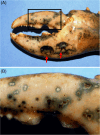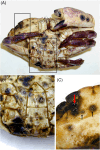Shell disease syndromes of decapod crustaceans
- PMID: 36708190
- PMCID: PMC10946978
- DOI: 10.1111/1462-2920.16344
Shell disease syndromes of decapod crustaceans
Abstract
The term shell disease subsumes a number of debilitating conditions affecting the outer integument (the carapace) of decapod crustaceans, such as lobsters and crabs. Herein, we seek to find commonality in the aetiology and pathology of such conditions, and those cases that result in the progressive erosion of the cuticle through to the visceral tissues by a cocktail of microbial-derived enzymes including lipases, proteases and chitinases. Aquimarina spp. are involved in shell disease in many different crustaceans across a wide geographical area, but the overall view is that the condition is polymicrobial in nature leading to dysbiosis within the microbial consortium of the damaged cuticle. The role of environment, decapod behaviour and physiology in triggering this disease is also reviewed. Finally, we provide a conceptual model for disease aetiology and suggest several avenues for future research that could improve our understanding of how such factors trigger, or exacerbate, this condition.
© 2023 The Authors. Environmental Microbiology published by Applied Microbiology International and John Wiley & Sons Ltd.
Conflict of interest statement
The authors declare that they have no conflict of interest.
Figures





References
-
- Albalat, A. , Johnson, L. , Coates, C.J. , Dykes, G.C. , Hitte, F. , Morro, B. et al. (2019) The effect of temperature on the physiological condition and immune‐capacity of European lobsters (Homarus gammarus) during long‐term starvation. Frontiers in Marine Science, 6, 281.
-
- Albalat, A. , Zacarias, S. , Coates, C.J. , Neil, D.M. & Planellas, S.R. (2022) Welfare in farmed decapod crustaceans, with particular reference to Penaeus vannamei . Frontiers in Marine Science, 677, 886024. Available from: 10.3389/fmars.2022.886024 - DOI
Publication types
MeSH terms
LinkOut - more resources
Full Text Sources
Miscellaneous

